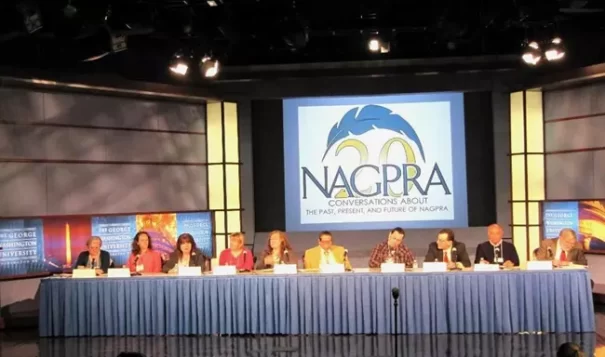Explainer A data-driven story that provides background, definition and detail on a specific topic.
The Repatriation Project: reuniting tribes with Native human remains and sacred items
 NAGPRA Q&A Session. NPS Photo courtesy of NPS.gov
NAGPRA Q&A Session. NPS Photo courtesy of NPS.gov
How ProPublica’s series, The Repatriation Project, is shedding light on the flaws of NAGPRA.
Every year, since 1983, the third Monday in January is reserved to honor Dr. Martin Luther King Jr. and his mission to raise public awareness of racism and for people of all races to be judged by the content of their character – not the color of their skin. The civil rights movement is not limited to a singular race and has been a fight that cultures of color have been fighting for decades.
In honor of Dr. King’s fight for equality across races, it only seemed fitting for Buffalo’s Fire to present our readers with The Repatriation Project, ProPublica’s series addressing how many of America’s institutions still maintain control of the remains of hundreds of thousands of Native Americans, including sacred items. In 1990, the passing of the Native American Graves Protection and Repatriation Act, NAGPRA, was the federal law’s way of aiding in the return of remains and sacred items. However, many tribes are still waiting for compliance.
Congress passed NAGPRA in October 1990, and President George H. Bush signed it into law on Nov. 16, 1990. The Department of the Interior issues regulations to interpret and implement NAGPRA, which have the full force and effect of the law. NAGPRA established the rights of Indian tribes and their lineal descendants to obtain repatriation of certain human remains, funerary objects, sacred objects, and objects of cultural heritage from federal agencies and museums. Likewise, the Indian Arts & Crafts Act, IACA, was also enacted in 1990 with the intention of protecting tribal cultural resources by preventing the sale of goods that are falsely represented to be made by Native Peoples.
Unfortunately, the Indian Arts and Crafts Act has been ineffective due to inadequate enforcement and weak penalties for violations. The efforts of NAGPRA have not been as effective as Native Tribes hoped, with many museums and universities still non-compliant after over three decades.
The National Park Service provides policy for complying with the laws and regulations established under NAGPRA. Through the National NAGPRA program, a database has been created, which includes compliance documents with inventories, summaries, Federal Register notices, and newspaper notices – with data searchable on the site.
Additionally, the National Park Service also provides templates for compliance with the National NAGPRA program covering Federal or Tribal Lands, inventories of human remains, summaries of cultural items, and more. If the templates do not fit specific needs, requests can be made to the National NAGPRA Program directly.
Each year, the National NAGPRA Program creates program reports that summarize a variety of information, including program expenditures, notice publication statistics, grant information, the status of draft regulations, and the status of disputes.
On Oct. 18, the Department of the Interior made a formal proposal to revise regulations to improve the implementation of NAGPRA. The Department is looking for public comment on the proposed rule through January 31, 2023. Written comments, identified by Regulations Identified Number, RIN, 1024-AE19, by only one method – the Federal eRulemaking Portal or by mail.
The Federal eRulemaking Portal can be found at https://www.regulations.gov, and provides detailed instructions for submission online. The direct link for making comments regarding NAGPRA is NPS-2022-0004-0001.
Comments made via mail can be submitted to: National NAGPRA Program, National Park Service, 1849 C Street, NW, Mail Stop 7360, Washington, DC 20240, Attn: Melanie O’Brien, Manager, NAGPRA Rule Comments.
ProPublica’s series, The Repatriation Project, takes a look at how the remains of more than 100,000 Native Americans are held by United States institutions, despite the passing of the 1990 NAGPRA law, and how tribes are working to regain possession of these remains. ProPublica is on a mission to bring awareness to the injustices and how Native American human remains and other sacred possessions have yet to be returned to their rightful homes.
Through the series, Buffalo’s Fire readers will get an in-depth look at the problem and how you can help with the repatriation of these sacred remains and items.
References:
https://www.congress.gov/bill/101st-congress/house-bill/5237
https://www.nps.gov/subjects/nagpra/law-and-policy.htm
https://www.nps.gov/subjects/nagpra/regulations.htm
https://www.nps.gov/subjects/nagpra/databases.htm
https://www.nps.gov/subjects/nagpra/templates.htm
https://www.nps.gov/subjects/nagpra/reports.htm
https://www.usbr.gov/nagpra/
https://www.nps.gov/subjects/nagpra/index.htm
https://www.ncai.org/policy-issues/community-and-culture/cultural-protection-and-nagpra
https://www.propublica.org/series/the-repatriation-project
